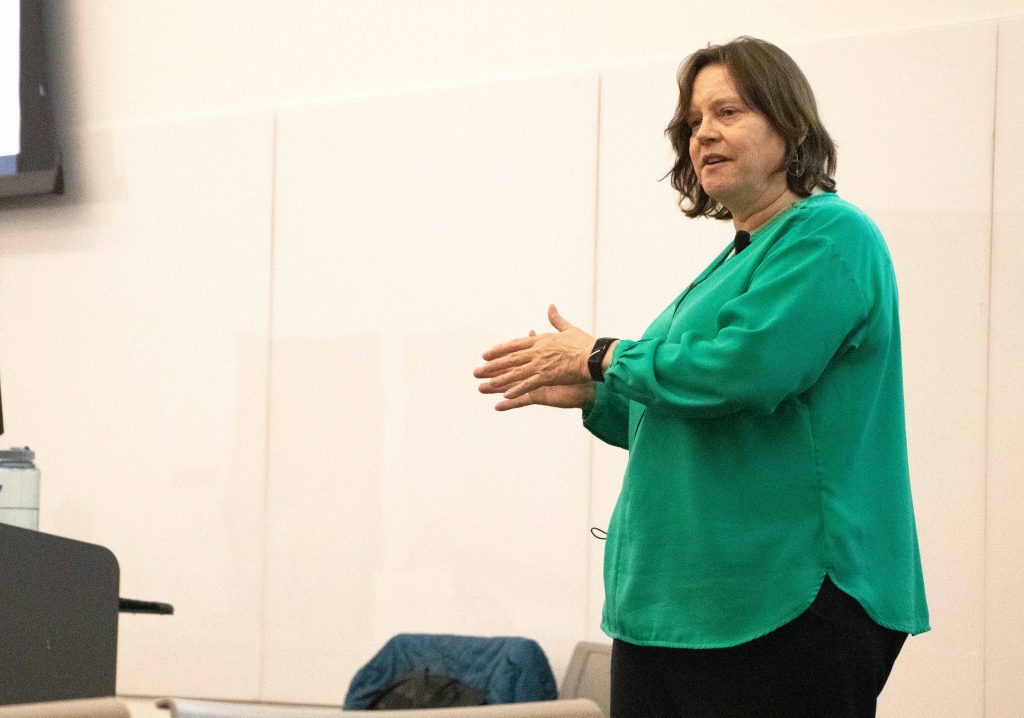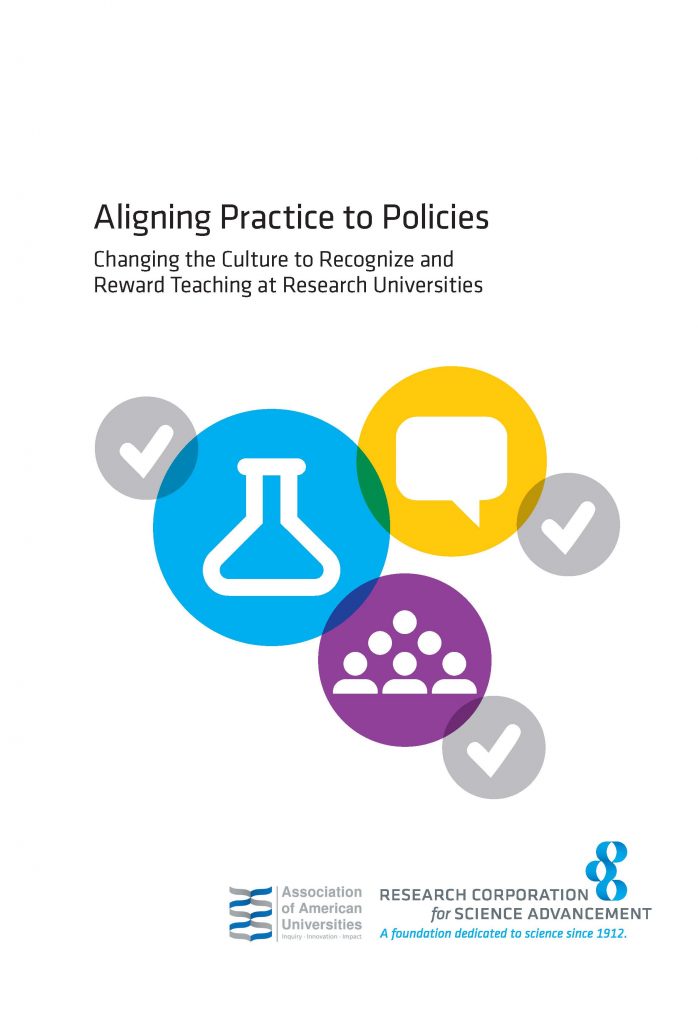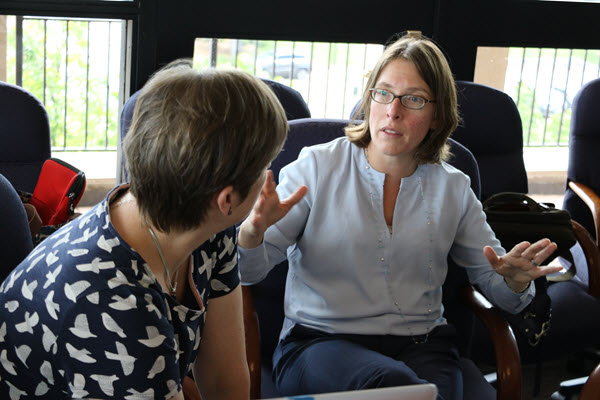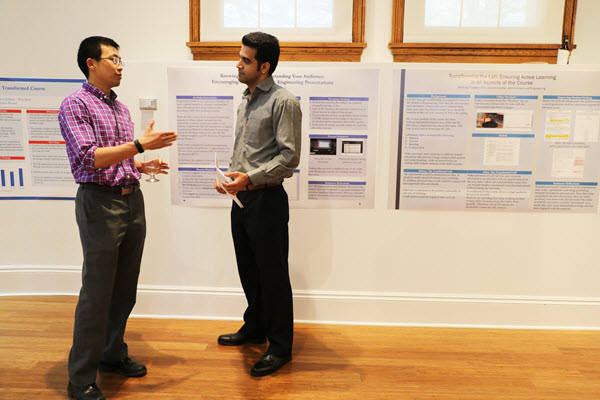By Doug Ward
Martha Oakley couldn’t ignore the data.
The statistics about student success in her discipline were damning, and the success rates elsewhere were just as troubling:

- Women do worse than men in STEM courses but do better than men in other university courses.
- Students of color, first-generation students, and low-income students have lower success rates than women.
- The richer students’ parents are, the higher the students’ GPAs are.
“We have no problem failing students but telling ourselves we are doing a good job,” said Oakley, a professor of chemistry and an associate vice provost at Indiana University, Bloomington. “If we are claiming to be excellent but just recreating historical disadvantages, we aren’t really doing anything.”
Oakley spoke to about 40 faculty and staff members last week at a CTE-sponsored session on using mastery-based grading to make STEM courses more equitable. The session was part of a CTE-led initiative financed by a $529,000 grant from the Howard Hughes Medical Institute, with participants from KU working with faculty members from 13 other universities on reducing equity gaps in undergraduate science education.
The work at KU, IU, and other universities is part of a broader cultural shift toward helping students succeed rather than pushing them out if they don’t do well immediately. Most disciplines have been changing their views on student success, but there has been increasing pressure on STEM fields, which have far lower numbers of women and non-white students and professionals than many other fields.
Oakley said she started digging deeper into university data about five years ago after attending a conference sponsored by the Association of American Universities and getting involved in IU’s Center for Learning Analytics and Student Success. She also began working with a multi-university initiative known as Seismic, which focuses on improving inclusiveness in STEM education.
She and some colleagues started by asking questions about the success rates of women in STEM but then recognized that the problem was far wider.
“And so we looked at each other and said, ‘Yeah, forget the women. Let’s worry about this bigger problem,’ ” Oakley said. “And we didn’t forget the women. We just had confidence that the things that we would do to address the other groups would also help women.”
Using analytics to guide change
In last week’s talk, she used many findings from Seismic and the IU analytics center as she made a case for changing the approach to teaching in STEM fields. For instance, she said, 20% to 50% of students at large universities fail or withdraw from early chemistry courses, with underrepresented minority students at the high end of that range. Students who receive a B or lower in pre-general chemistry courses have less than a 50-50 chance of succeeding in general chemistry.
She also talked about a personal revelation the data brought about. In 2011, she said, she received a university teaching award, and “by every metric, I knew I was doing my job really well.”
The data she saw a few years later suggested otherwise, showing that 37% of underrepresented students and 24% of the other students in her classes dropped or failed in the year she received the award.
“The major part of the story is we’ve all been trained in our disciplines to teach in a certain way that really was never particularly effective,” Oakley said.
We have learned much about how people learn but have continued with ineffective teaching strategies. That needs to change, she said.
“One really simple thing we can do is to say we only give teaching awards to people who actually demonstrate that their students have learned something,” she said.
A mastery-based approach
To address the problem at IU, Oakley has been experimenting with a mastery-based approach to grading.
The way most of us grade exacerbates inequities, Oakley said. It emphasizes superficial elements (basically memorization) and does nothing to reward learning from mistakes, persistence, or teamwork – “all the things that matter in life.” Grades are also poor predictors of how well students will do in jobs or in graduate school, she said.
Mastery-based grading gives students multiple attempts to demonstrate understanding of course material. It is related to another approach, competency-based learning, which also gives students multiple opportunities but focuses on application rather than simple understanding.
Oakley started shifting her class to mastery-based grading by taking broad learning goals and breaking them into smaller components: things like identifying catalysts and intermediates, using reaction order, and explaining why rates change with temperature. She also eliminated a grading curve. That was especially hard, she said, because she had internalized the notion of grade distributions, an approach that punishes failure and provides little opportunity for students to learn from mistakes.
She still uses quizzes and exams, with students taking quizzes the evening before class and then working in groups the next day to create a quiz key. That helps them learn from mistakes, knowing they will see similar questions on a quiz the following week.
At KU, Chris Fischer and Sarah LeGresley Rush have used a similar approach in physics courses, with results suggesting that a mastery approach helps students learn concepts in ways that stay with them in later engineering courses.
Oakley’s initial work has also showed potential, with DFW rates in her class falling to 8% and the average grade rising to a B. That was better than other sections of the class, although students didn’t do as well in later courses. Oakley isn’t discouraged, though. Rather, she said, she continues to learn from the process, just as her students do.
“We’ve really only scraped the tip of the iceberg,” she said.
Building on experience
Oakley’s advocacy for equity in STEM education is informed by experience. When she started at IU in 1996, she said, she was the only woman in a department of 42. That was isolating and frustrating, she said. Through her work in STEM education, she hopes to improve the opportunities for women and students of color.
“We’ve got to be both equitable and striving for excellence,” she said.
Only through experimentation, failure, and persistence can we start breaking down systemic barriers that have persisted for too long, she said.
“The system is broken,” Oakley said. “We are not ready for the students of the future – or even the present.”
Doug Ward is associate director of the Center for Teaching Excellence and an associate professor of journalism and mass communications.













Recent Comments